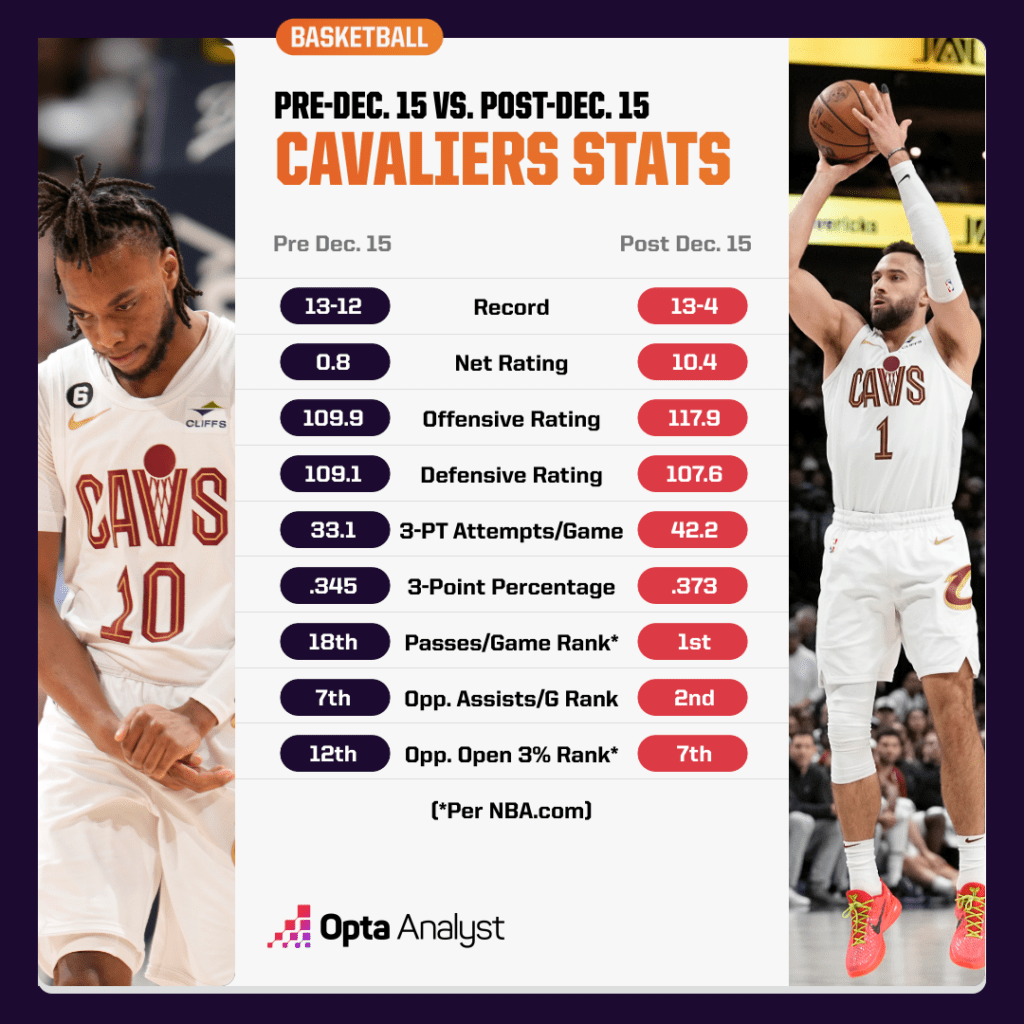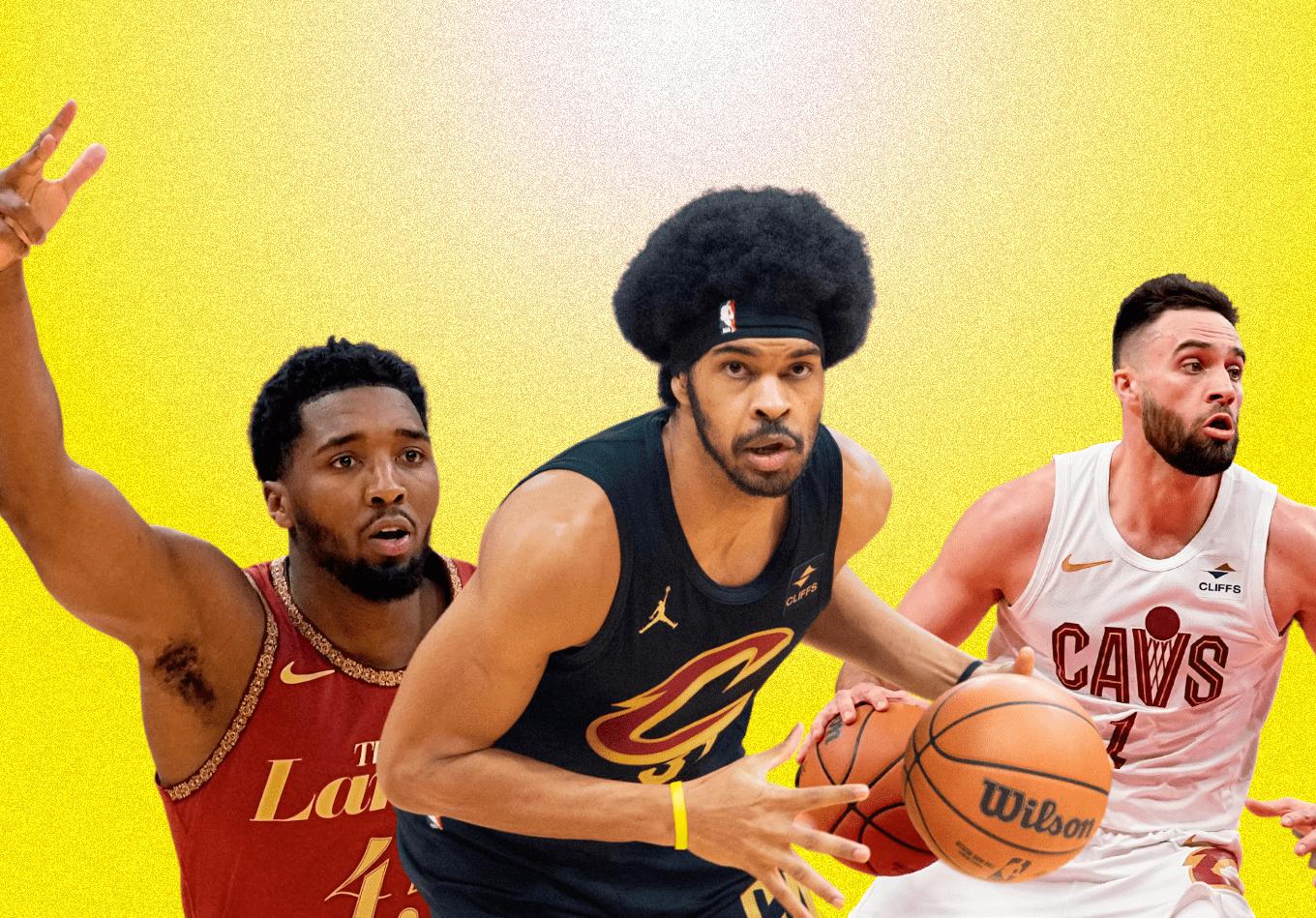On Dec. 15, the Cleveland Cavaliers announced that Darius Garland and Evan Mobley would both be out for significant amounts of time with jaw and knee injuries, respectively.
The Cavaliers were fresh off a loss to the Boston Celtics that had put them at 13-12 and demoted them to ninth in the Eastern Conference. And now, they would be forced to go months without two of their four best players.
Bye-bye season.
But that’s not what happened. Instead, the Cavaliers have been hotter than fish grease, winning 13 of their last 17 games and graduating to fourth in the East overall.
This run has been a season-saving development. But it also begs the question: Are the Cavs better without Garland and Mobley?
More Shooting, More Spacing, More Movement
We can start with the offense. Before Dec. 15 (the point of inflection in this story), the Cavaliers were 24th in offensive rating (109.9). Since then, they have been eighth in that category (117.9).
Mobley, despite being a phenomenal defender (99th percentile in defensive DRIP), has yet to take the leap people have been hoping for offensively. He’s a good rim runner in the pick-and-roll, but his frailer physique makes it hard for him to punish mismatches on the interior.
And more importantly, he isn’t a credible shooting threat (career 23% 3-point shooter). So, when he shares the court with Jarrett Allen (a great midrange shooter but poor 3-point shooter), the Cavaliers’ spacing goes in the gutter.
Look how cluttered the paint was when they played the New York Knicks last season:
With Mobley out, Cleveland has had the chance to assign more minutes to the hired guns (Max Strus and Georges Niang) it acquired this offseason. Sam Merrill – the fourth-year guard who was the last player taken in the 2020 NBA Draft – has also been a pleasant development, averaging a conversation rate of 43.2% on his 6.0 3-pointers per game.
Even Dean Wade (who has been Cleveland’s starting four in Mobley’s absence) provides a spacing boost (he’s hitting 40.3% of his 3.8 3s per game).
After ranking 18th in 3-point attempts per game (33.1) and 26th in 3-point percentage (.345) through Dec. 15, the Cavaliers rank second (42.2) and are now second and 13th since then.
Look how much cleaner the paint looks now:
Along with being splendid marksmen, Strus and Merrill operate in a similar fashion to the way that Kevin Huerter does for the Sacramento Kings in that they execute quick-hitting movement-based on-ball and off-ball actions.
And as a result, the Cavs have had some of the best ball movement in the NBA (arguably the best). Since Dec. 15, the Cavaliers have led the league in passes made per game. Before that, they were just 18th.
Better Than Ever on Defense
Without Mobley, the Cavaliers are shooting the ball more efficiently, spacing the floor more effectively, and playing with more connectivity. But given his status as a defender, surely their recent offensive fortune comes at the cost of their defense.
Before Dec. 15, Cleveland ranked seventh in defensive rating (109.1). Since then, they have fallen to… first in defensive rating (107.6). No, that wasn’t a typo. The Cavaliers have been the best defense in the NBA over the last 17 games without the guy who ranked third in the NBA Defensive Player of the Year voting.

Is Mobley actually a bad defender? No, but Garland isn’t a very good one (42nd percentile in D-DRIP). The effort is there, but he’s still a 6-foot-1 guard in a game that favors giants.
Normally, a team can hide one little guy, especially when that guy is as talented of an offensive player as Garland is (93rd percentile in offensive DRIP). But the problem is he shares a backcourt with Donovan Mitchell (6-3). And it’s a lot harder to navigate having two smaller guys on defense than it is to have just one.
With Garland on the sidelines, Cleveland can play more defensive-first wings and forwards like Wade and Isaac Okoro. The latter is a below-average shooter for his position, but that’s OK because Cleveland is getting more spacing from the power forward spot without Mobley.
Strus’ years spent rising up the ranks of the Miami Heat organization have made him one of the more underrated perimeter defenders in basketball. He’s been one of the best acquisitions of the offseason. Among non-rookies, he ranks fourth in DELTA – a metric that tracks the improvement in a player’s DRIP since the start of the season.
To his credit, Mitchell has been super locked-in and engaged on the defensive side of the ball, as indicated by the fact that his steal rate this year is at a career-best 2.7%. And like CJ McCollum, he’s reaping the benefits of no longer sharing the backcourt with someone smaller than him. Now, he can draw the matchup against the other team’s weakest offensive player (an honor Garland normally gets).
With more defense and size on the floor, Cleveland has experienced an increase in its point-of-attack defense and rim protection (two important parts of great defenses).
Since Dec. 15, Cleveland is sixth in opponent points in the paint per 100 possessions – the team was 10th before that. Also, in that time, the Cavaliers are first in opponent assists per 100 (a good proxy for point-of-attack defense, as teams that surrender a lot of blow-bys also usually concede a lot of assisted field goals) – they were seventh before that.
Lastly, there hasn’t been a drastic change in Cleveland’s opponent shooting luck (measured by opponent wide-open 3-point percentage). So, the team’s recent success can’t be attributed to that.
(Sidebar: Caris LeVert and Craig Porter Jr. aren’t as good at running an offense as Garland. But they are great at leading bench lineups. So, one of them – LeVert when he’s healthy, Porter when he’s not – buoys the offense when Mitchell is off the floor).
What Does Cleveland Do Now?
This isn’t intended to be a demerit on Mobley and Garland’s individual excellence. The issue here is fit. Mobley and Allen have overlapping skills (defensive anchors who can’t stretch the floor). And so do Garland and Mitchell (undersized offensive stars).
Cleveland’s stars are redundant of each other. And redundancies produce inefficiencies. So, what do the Cavs do about this conundrum?
Some have suggested that Cleveland stagger the Garland/Mobley minutes from the Mitchell/Allen ones and let Garland/Mobley be flanked by shooters and defenders. Then, do the same with Mitchell/Allen. This way, you always have a dynamic duo on the court.
When you think about it, this formula isn’t too different from the theory of Mitchell’s old Utah Jazz team. Back then, the Jazz would try to surround Mitchell and Rudy Gobert with as much shooting and defense as possible. This model leads to great regular-season success. But as we saw in Utah, the ceiling of a team like this is limited.
The reason for this is the role players sharing the court with them are flawed. We’ll keep the focus on Cleveland here and look at Okoro. He’s a great defender, but we saw last year that his offensive limitations can get him played off the floor in the playoffs.
Merrill is a wickedly good shooter, but his size will make him a moving target on defense. Wade is hitting shots now, but will this hold up in the postseason? Niang only averaged 14.3 minutes per game during the playoffs last year. And the Philadelphia 76ers were a minus-3.9 per 100 in his minutes.
Cleveland can be a great regular-season team by following this strategy. But if the Cavs want to win big in the playoffs, they need to consider trading one or two of their core four to acquire a two-way wing/forward or two that they can trust in the postseason.
This isn’t a bad problem to have. All four of those guys are valuable assets who could net Cleveland the player(s) it needs in a trade. It’s just about the front office pushing the right button on who it trades and who it gets back.
But if they do, watch out for the Cavaliers. With the right move, they could compete for an NBA title.
Check out our MLB and NBA coverage, and our NFL picks and college basketball predictions. Follow us on X and Instagram for more!
